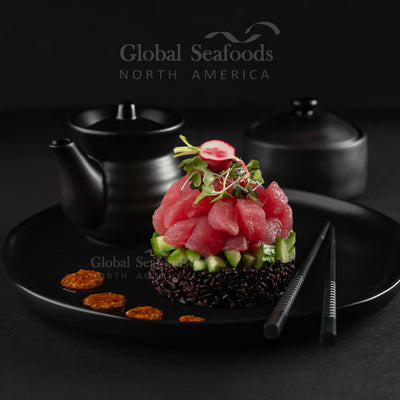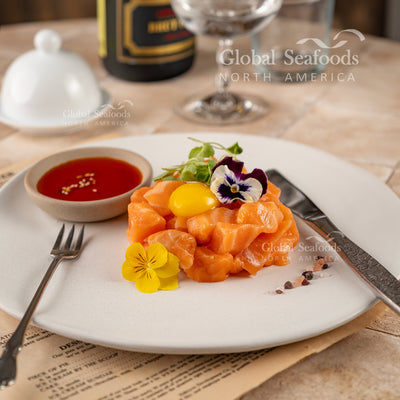Poke Tuna 101: Your Complete Guide to This Delicious Delicacy

Poke Tuna 101: Comprehensive Guide
Poke tuna, an iconic Hawaiian dish, combines raw fish, fresh ingredients, and bold flavors into a versatile and nutritious meal. Its growing global popularity showcases its appeal to diverse palates. Whether you're curious about its history or looking for tips to create the perfect poke bowl, this guide covers everything you need to know about poke tuna.
Explore the origins, variations, health benefits, and the best tuna options for poke. Let's dive into this flavorful journey!
What Is Poke Tuna? The Basics Explained
Poke tuna (pronounced poh-kay) is a Hawaiian dish traditionally made with raw tuna diced into cubes and seasoned with a mix of sea salt, soy sauce, sesame oil, and other ingredients. The word "poke" means "to cut into pieces," reflecting the dish's simple preparation.
According to the Hawaiian Culinary Foundation, poke originated from native Polynesians who used locally sourced fish. Modern versions often incorporate Japanese, Korean, and American flavors, making poke a true fusion dish.
Why Is Tuna the Star of Poke?
Tuna, particularly ahi tuna, is prized for its:
- Freshness: Its clean taste allows the seasoning to shine.
- Texture: Firm yet tender, it’s perfect for slicing into cubes.
- Versatility: Tuna adapts to various marinades and toppings.
For premium-quality tuna, try:
Origins and Evolution of Poke Tuna
The traditional Hawaiian poke was simple, featuring just fish, salt, and seaweed. However, as immigrants brought new ingredients, poke evolved. Soy sauce, sesame oil, and chili flakes are now staples, thanks to Japanese and Korean culinary influences.
Famed chef Roy Yamaguchi notes, “Poke is the perfect example of Hawaii’s melting pot culture. It’s rooted in tradition yet open to innovation.”
The Different Variations of Poke Tuna
Poke’s versatility lies in its ability to adapt to different tastes and ingredients. Here are some popular styles:
1. Classic Hawaiian Poke
- Ingredients: Fresh ahi tuna, Hawaiian sea salt, ogo seaweed, roasted kukui nuts.
- Flavor Profile: Pure, fresh, and nutty.
- Best Tuna for This Style: Fresh Albacore Tuna.
2. Shoyu Poke (Soy Sauce Poke)
- Ingredients: Ahi tuna, soy sauce, sesame oil, green onions, and sesame seeds.
- Flavor Profile: Savory and umami-packed.
3. Spicy Tuna Poke
- Ingredients: Tuna, sriracha, mayonnaise, masago, and chili oil.
- Flavor Profile: Creamy with a spicy kick.
- Perfect Tuna Choice: Bluefin Tuna.
4. Vegetarian Poke
- Substitute for Tuna: Cubed tofu, watermelon, or cooked chickpeas.
- Flavor Profile: Light and refreshing.
5. Sweet and Tangy Poke
- Ingredients: Tuna, mango, avocado, lime juice, and cilantro.
- Flavor Profile: Sweet and citrusy, ideal for summer meals.
How to Make Poke Tuna: A Step-by-Step Guide
Creating poke at home is easy with the right ingredients and a few simple steps.
Ingredients Needed
- Fresh, sushi-grade tuna (Shop Tuna).
- Soy sauce, sesame oil, and rice vinegar for the marinade.
- Toppings: avocado, cucumber, edamame, or seaweed salad.
Preparation Steps
- Dice the Tuna: Cut into bite-sized cubes.
- Mix Marinade: Combine soy sauce, sesame oil, and other seasonings.
- Marinate the Tuna: Let it sit for 15–30 minutes to absorb flavors.
- Assemble the Bowl: Layer rice, greens, or noodles, and top with marinated tuna and extras like sesame seeds or crispy onions.
Health Benefits of Poke Tuna
Poke tuna is as nutritious as it is delicious. Here’s why it’s a healthy choice:
- Rich in Omega-3s: Supports brain health and reduces inflammation.
- Low in Calories: Ideal for weight management.
- High in Protein: Aids muscle recovery and growth.
Dr. Frank Hu, from Harvard T.H. Chan School of Public Health, highlights that consuming fish like tuna “can lower the risk of cardiovascular disease significantly.”
Tips for Choosing the Best Tuna for Poke
Not all tuna is created equal. Here’s what to look for:
- Sushi-Grade Label: Indicates it’s safe for raw consumption.
- Firm Texture: Should bounce back when pressed lightly.
- Bright Color: Fresh tuna is vibrant, not dull.
Recommended options include:
Poke Tuna FAQs
1. Can I use frozen tuna for poke?
Yes, if it’s sushi-grade and properly thawed.
2. Is poke gluten-free?
Traditional recipes are gluten-free, but use tamari instead of soy sauce for gluten-free options.
3. What’s the difference between ahi tuna and bluefin tuna?
Ahi tuna is leaner and has a milder flavor, while bluefin is richer and more buttery.
4. How long can poke be stored?
Poke is best eaten fresh but can be refrigerated for up to 24 hours.
5. Can I make poke with cooked fish?
Yes, cooked shrimp or grilled fish can replace raw tuna.
Serving and Pairing Suggestions
Poke is versatile and can be enjoyed in many ways:
- As a Bowl: Over rice or quinoa.
- As an Appetizer: Serve with taro chips or crackers.
- With Drinks: Pair with light beer, sake, or sparkling water.
Enhance Your Poke Experience with Premium Products
For more inspiration, check out recipes and ideas on the Global Seafoods YouTube Channel.
Conclusion
Poke tuna embodies the perfect blend of simplicity and sophistication. With high-quality ingredients and a touch of creativity, you can craft a dish that’s as nutritious as it is delicious. Whether you’re a fan of traditional Hawaiian flavors or modern twists, poke tuna offers endless possibilities.
So why wait? Dive into the vibrant world of poke and bring a taste of Hawaii to your table!
Also in News

How to Make Sea Bream Sushi With Dry-Aged Tuna & Crab Roll — Step-by-Step With Chef Joshua
A complete guide to making Sea Bream sushi at home, including filleting, curing, slicing, and building a Dry-Aged Tuna & Crab sushi roll. Chef Joshua shares professional tips for restaurant-quality results.

The Boiled Crab in Popular Culture: From Cajun Cuisine to Trendsetting Restaurant Phenomenon
From spicy Cajun-inspired seafood boils to hands-on dining experiences, The Boiled Crab has left a unique mark on popular culture. Discover its cultural roots and culinary influence.

Boiled Crab for Game Night: Everything You Need for a Perfect Seafood Party
Take your game night to the next level with a Boiled crab party. Learn the best recipes, cooking tips, and hosting hacks for a memorable seafood feast.




